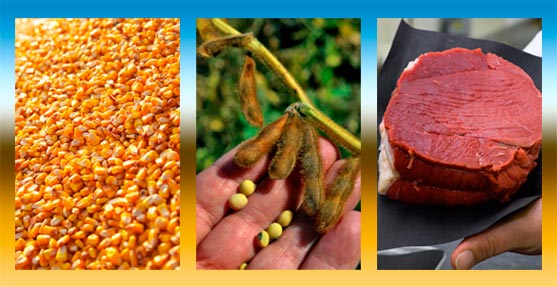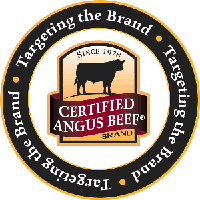MARKETING...

In The Cattle Markets
Supply and demand report recap.
Friday, Nov. 9, USDA and the World Agricultural Outlook Board released their monthly World Agricultural Supply and Demand Estimates (WASDE) report. The report was widely viewed as having a bearish tone for crops given the significant increases in supplies and carryover for soybeans compared to what was expected. This has spilled over into other grain and oilseed markets in the days that have followed.
Nonetheless, corn supply and use were left mostly unchanged from the October WASDE report, with the only noticeable change being an increase in projected corn imports from 75 million bushels (bu.) to 100 million bu. (up 33%). Estimated yield per acre was raised slightly to 122.3 bu., compared to an average of analyst expectations of 122.1 and 122.0 reported the previous month. This raised U.S. production 19 million bu. to 10.725 billion. Read more.
 Sixth Record Sales Year for Top Quality Beef Brand
Sixth Record Sales Year for Top Quality Beef Brand
CAB celebrates another record despite market challenges
Amid U.S. cattle and beef supplies curtailed by economics and drought, Certified Angus Beef LLC (CAB) reported record sales of its signature brand for a sixth consecutive fiscal year that ended Sept. 30.
More than 16,000 licensed partners around the world made that possible by capitalizing on the consistent dining experience the premium brand brought to consumers as prices for all beef continued higher. Sales totaled 811 million pounds (lb.), surpassing last year's record by 4 million lb. and up 49% from just six years ago. During that period known for its challenging consumer economy, Certified Angus Beef® (CAB®) brand sales advanced from representing 5.6% to now more than 9.6% of all federally inspected cattle harvested. Read more.
CAB Mythbusters
What they thought they knew that just ain't true.
It’s always interesting to hear where some of my co-workers have been lately — from South Korea and Colombia to New York City and Las Vegas. We have folks working with food distributors, restaurants and retailers across the globe. They analyze what drives their customers and how we can help meet that demand.
I sometimes joke that those locations sound a bit more glamorous than visiting places like Sterling, Colo., or Tabor, Iowa, but I won’t complain. I love my job and all the people I get to meet in cattle country.
Thinking about those travels reminds me of our 100-some employees and this myth:
Myth — It’s easy for you guys to give out recommendations and say things like, “People will pay more for high quality.” You’re stuck there in your offices, and we’re out here in the real world.
Fact — We are in the trenches in every segment of the beef industry. Read more.
Beef Packer Margins Leaking a Lot of Red Ink
The Source
The influential tag gift.
Slam! The back door blew shut from the wind. I knew Dad had finished feeding the cows and would be coming upstairs to wake me up. Dad stood at the bottom of the stairs and called for me to come down for breakfast. He told me to put on my warm chore clothes, too.
He must have a new calf that needs bottle-fed. I love to bottle-feed the calves, but this was Christmas morning and there were presents to unwrap. Couldn’t we have breakfast and open presents, then feed the calf? Read more.
Market Changes Affecting Feedlot Placements
Sharply higher feed costs have forced a dramatic reduction
in the number of cattle placed on feed.
Since June, when corn prices started their upward move, feedlots have reduced feedlot cattle placements by almost 1.3 million head compared to the previous year (if we include the average October estimate). Some of this comparison may be skewed a bit by the fact that in 2011 feeders in the Southern Plains were forced to market calves early due to drought pressures and lack of adequate pastures.
This year, pastures in the Southern Plains were somewhat better, which limited placements of light cattle from that region. Still, overall U.S. pasture and range conditions in 2012 were even worse than in 2011. Which brings us back to corn and other feeds. While drought is a factor in pushing calves into feedlots, it is not a determinant. The matrix of feed, feeder-cattle and live-cattle prices is what determines the pace of feedlot placements. Read more.
Winter Backgrounding Opportunities
Kentucky calf prices appear to have decreased in the last few weeks as we approach winter and start to see larger calf runs. Feed prices have also softened over the last month or two and may be providing some opportunities for winter backgrounders. The purpose of this article is to examine potential returns to winter backgrounding programs.
At the time of this writing (Oct. 25, 2012), spring feeder-cattle futures were trading in the low- to mid-$150s. As winter backgrounders consider purchasing calves today, they should be looking at these feeder-cattle futures contracts for some sense of likely feeder-cattle prices in the spring. A futures price in the $150s suggests a likely Kentucky price for 850-pound (lb.) steers in the low $140s come spring — a likely sale value of $1,190 (850 lb. ✕ $1.40). This should be in the back of producers’ minds as they bid on calves this fall. Read more.
September Beef Exports Lower
USMEF provides review of September meat exports; beef exports well below a year ago while pork exports were steady.
U.S. pork exports in September were steady with last year’s volume, while beef exports were well below a year ago. Despite sluggish volumes, however, the value of both pork and beef exports through the third quarter of 2012 remains ahead of last year’s record-setting pace, according to statistics released by USDA and compiled by the U.S. Meat Export Federation (USMEF).
“We are definitely in a challenging economic environment, which is making it difficult to match last year’s export volumes,” said Philip Seng, USMEF president and CEO. “But our products continue to command an excellent price in the international markets and provide substantial returns to U.S. producers, which is critically important at a time when they face extremely high production costs.” Read more.
Angus Calendar
To view the Angus Calendar, a complete list of Angus sales, click here.












